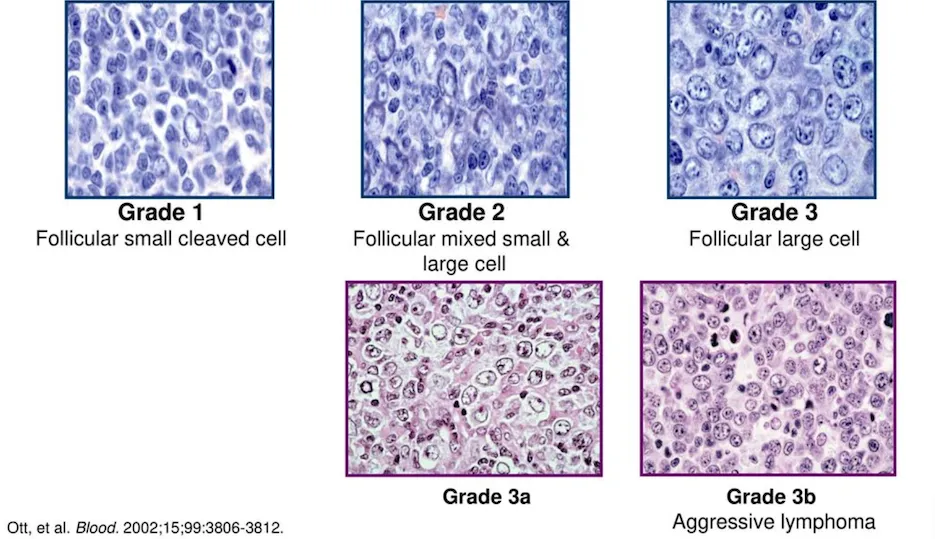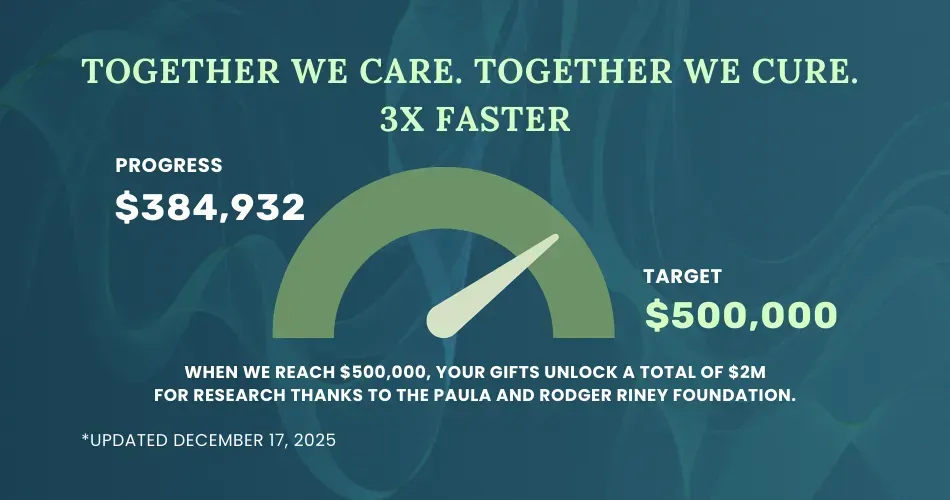What are the Stages of Follicular Lymphoma?
What are the stages of follicular lymphoma? How do these help doctors know what to expect from the disease and which treatments may be appropriate? Learn the answers to these questions below!
Follicular Lymphoma Staging Systems
Follicular lymphoma is a type of cancer that affects follicular center B-cells. B-cells normally help fight infections. In follicular lymphoma, the B-cells undergo genetic mutations that prevent them from dying at the appropriate time. This leads to abnormal growth in areas of the body that contain these B-cells like the lymphatic system. Generally, follicular lymphoma progresses slowly. People with the disease may not experience symptoms for many years.
Various staging systems help categorize follicular lymphoma’s progression. Treatments often vary depending on the stage of the cancer. Below, learn about the staging systems for follicular lymphoma.
- The Lugano Classification (modification of the Ann Arbor staging system)
- Stage 1 (limited): Follicular lymphoma cells are found in one lymph node.
- Stage 2 contiguous (limited): Follicular lymphoma cells are found in lymph node groups next to each other.
- Stage 2 non-contiguous (limited): Follicular lymphoma cells are found in two or more lymph node groups on the same side of the diaphragm.
- Stage 2 bulky (can be limited or advanced): Follicular lymphoma cells have accumulated in an area to create a mass 7.5 centimeters or larger.
- Stage 3 (advanced): Follicular lymphoma cells are found in lymph nodes above and below the diaphragm on the same side of the body. Or, they are found in lymph nodes above the diaphragm and in the spleen.
- Stage 4 (advanced): Follicular lymphoma cells have spread outside the lymph system into other areas of the body, which is sometimes called extranodal disease.
- International Prognostic Index (IPI)
- A scoring system that reviews the likely course of the disease. A follicular lymphoma international prognostic index is often abbreviated as FLIPI-1. It is based on your age, lactate dehydrogenase (LDH) test, hemoglobin, the number of lymph node areas with cancer, and the Lugano stages.
- The GELF Criteria (Groupe d'Etude des Lymphomes Folliculaires) indicate that there is a lot of lymphoma in the body, often referred to as a high tumor burden. If the below signs and symptoms of a high tumor burden are present, treatment is recommended to start.
- Three or more lymph node areas are bigger than 3 cm.
- Bulky disease is found (lymphoma areas measure 7 cm or larger).
- Your spleen is enlarged.
- There is fluid buildup around your lungs or in your abdomen.
- Your platelet count is low and/or your granulocyte (a type of white blood cell) count is low.
- You have symptoms like fever with no infection, drenching night sweats, fatigue, and unexplained weight loss (referred to as B symptoms). Only 20% of people with follicular lymphoma experience B symptoms.
- Leukemic phase (follicular lymphoma cells are found in the bone marrow or blood).
What Does Follicular Lymphoma Look Like?
Apart from staging, specialists will also examine the follicular lymphoma cells underneath a microscope and grade them based on their appearance. Certain cell patterns indicate what type of follicular lymphoma it is and can help identify the disease's prognosis.
- Grades 1, 2, and 3A are considered to be low grade
- Classic follicular lymphoma
- Slower growing
- Grade 3B is high grade
- More aggressive, faster growing
- Comparable to another aggressive form of lymphoma called diffuse large B-cell lymphoma (DLBCL)

Based on My Follicular Lymphoma Stage, When Do I Start Treatment?
If you have stage 1 or 2 follicular lymphoma, radiation may be recommended to remove lymph nodes that contain cancer cells before the disease spreads to more lymph nodes.
If you don't meet the GELF criteria, you have what is called low tumor burden follicular lymphoma. Your doctor will likely recommend either observing the disease with no treatment or administering a monoclonal antibody infusion called rituximab (Rituxan, Genentech).
If you meet one of the GELF criteria, you have high tumor burden lymphoma, and treatment is recommended. The standard treatment for high tumor-burden follicular lymphoma is chemotherapy. However, specialists are working on moving away from chemotherapy toward treatments that strengthen your immune system to fight the disease, called immunotherapies.
Stay Informed with HealthTree News
Educated and empowered patients have better outcomes. That's why we want to help you learn more about your disease with the latest lymphoma news, including patient stories, treatment breakthroughs, and expert insights so you can make confident, informed decisions.
Sources:
- Lugano Classification for Hodgkin and Non-Hodgkin Lymphoma
- Follicular Lymphoma International Prognostic Index
- Non-Hodgkin Lymphoma Stages
- Recommendations for Initial Evaluation, Staging, and Response Assessment of Hodgkin and Non-Hodgkin Lymphoma: The Lugano Classification
- Groupe d'Etude des Lymphomes Folliculaires (GELF) Criteria
- Factors to Consider When Initiating Treatment for FL
- Follicular Lymphoma Grading
- Follicular Lymphoma
- What should I know when first diagnosed with Follicular Lymphoma?
What are the stages of follicular lymphoma? How do these help doctors know what to expect from the disease and which treatments may be appropriate? Learn the answers to these questions below!
Follicular Lymphoma Staging Systems
Follicular lymphoma is a type of cancer that affects follicular center B-cells. B-cells normally help fight infections. In follicular lymphoma, the B-cells undergo genetic mutations that prevent them from dying at the appropriate time. This leads to abnormal growth in areas of the body that contain these B-cells like the lymphatic system. Generally, follicular lymphoma progresses slowly. People with the disease may not experience symptoms for many years.
Various staging systems help categorize follicular lymphoma’s progression. Treatments often vary depending on the stage of the cancer. Below, learn about the staging systems for follicular lymphoma.
- The Lugano Classification (modification of the Ann Arbor staging system)
- Stage 1 (limited): Follicular lymphoma cells are found in one lymph node.
- Stage 2 contiguous (limited): Follicular lymphoma cells are found in lymph node groups next to each other.
- Stage 2 non-contiguous (limited): Follicular lymphoma cells are found in two or more lymph node groups on the same side of the diaphragm.
- Stage 2 bulky (can be limited or advanced): Follicular lymphoma cells have accumulated in an area to create a mass 7.5 centimeters or larger.
- Stage 3 (advanced): Follicular lymphoma cells are found in lymph nodes above and below the diaphragm on the same side of the body. Or, they are found in lymph nodes above the diaphragm and in the spleen.
- Stage 4 (advanced): Follicular lymphoma cells have spread outside the lymph system into other areas of the body, which is sometimes called extranodal disease.
- International Prognostic Index (IPI)
- A scoring system that reviews the likely course of the disease. A follicular lymphoma international prognostic index is often abbreviated as FLIPI-1. It is based on your age, lactate dehydrogenase (LDH) test, hemoglobin, the number of lymph node areas with cancer, and the Lugano stages.
- The GELF Criteria (Groupe d'Etude des Lymphomes Folliculaires) indicate that there is a lot of lymphoma in the body, often referred to as a high tumor burden. If the below signs and symptoms of a high tumor burden are present, treatment is recommended to start.
- Three or more lymph node areas are bigger than 3 cm.
- Bulky disease is found (lymphoma areas measure 7 cm or larger).
- Your spleen is enlarged.
- There is fluid buildup around your lungs or in your abdomen.
- Your platelet count is low and/or your granulocyte (a type of white blood cell) count is low.
- You have symptoms like fever with no infection, drenching night sweats, fatigue, and unexplained weight loss (referred to as B symptoms). Only 20% of people with follicular lymphoma experience B symptoms.
- Leukemic phase (follicular lymphoma cells are found in the bone marrow or blood).
What Does Follicular Lymphoma Look Like?
Apart from staging, specialists will also examine the follicular lymphoma cells underneath a microscope and grade them based on their appearance. Certain cell patterns indicate what type of follicular lymphoma it is and can help identify the disease's prognosis.
- Grades 1, 2, and 3A are considered to be low grade
- Classic follicular lymphoma
- Slower growing
- Grade 3B is high grade
- More aggressive, faster growing
- Comparable to another aggressive form of lymphoma called diffuse large B-cell lymphoma (DLBCL)

Based on My Follicular Lymphoma Stage, When Do I Start Treatment?
If you have stage 1 or 2 follicular lymphoma, radiation may be recommended to remove lymph nodes that contain cancer cells before the disease spreads to more lymph nodes.
If you don't meet the GELF criteria, you have what is called low tumor burden follicular lymphoma. Your doctor will likely recommend either observing the disease with no treatment or administering a monoclonal antibody infusion called rituximab (Rituxan, Genentech).
If you meet one of the GELF criteria, you have high tumor burden lymphoma, and treatment is recommended. The standard treatment for high tumor-burden follicular lymphoma is chemotherapy. However, specialists are working on moving away from chemotherapy toward treatments that strengthen your immune system to fight the disease, called immunotherapies.
Stay Informed with HealthTree News
Educated and empowered patients have better outcomes. That's why we want to help you learn more about your disease with the latest lymphoma news, including patient stories, treatment breakthroughs, and expert insights so you can make confident, informed decisions.
Sources:
- Lugano Classification for Hodgkin and Non-Hodgkin Lymphoma
- Follicular Lymphoma International Prognostic Index
- Non-Hodgkin Lymphoma Stages
- Recommendations for Initial Evaluation, Staging, and Response Assessment of Hodgkin and Non-Hodgkin Lymphoma: The Lugano Classification
- Groupe d'Etude des Lymphomes Folliculaires (GELF) Criteria
- Factors to Consider When Initiating Treatment for FL
- Follicular Lymphoma Grading
- Follicular Lymphoma
- What should I know when first diagnosed with Follicular Lymphoma?
Trending Articles
Get the Latest Follicular lymphoma Updates, Delivered to You.
By subscribing to the HealthTree newsletter, you'll receive the latest research, treatment updates, and expert insights to help you navigate your health.
Together we care.
Together we cure.
3x Faster.




